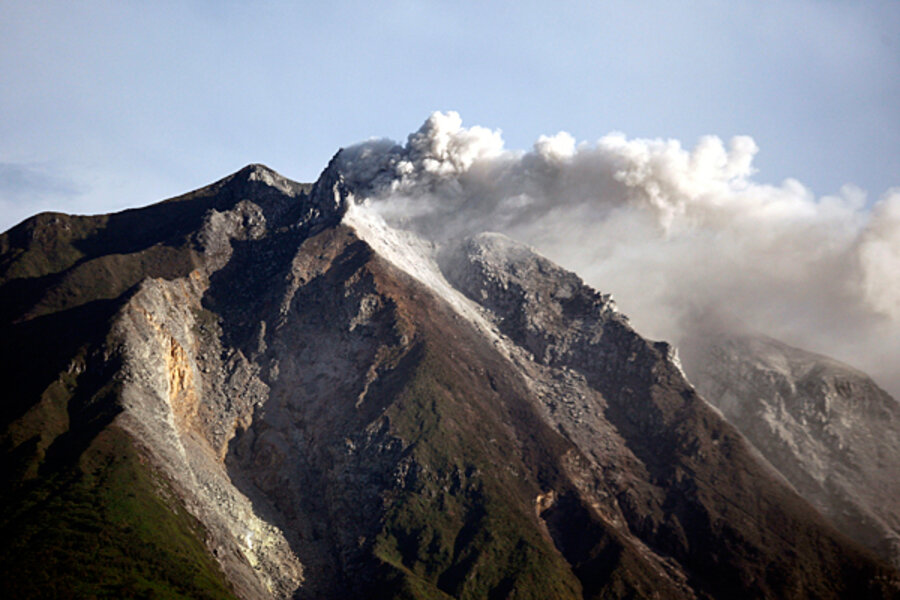Pompeii of the East? Clues to mystery mega volcano that blew 7 centuries ago.
Loading...
Researchers now have a leading suspect for one of the largest volcanic eruptions in the past 11,700 years – a summit in Indonesia that blew its top in the mid-13th century, burying the capital of an island kingdom and bringing a cold, flood-filled summer to many parts of Europe.
The suspect: Mt. Samalas on the island of Lombok, Bali's nearest eastern neighbor. [Editor's note: The original version cited the wrong direction from Bali.]
Sometime between AD 1257 and 1258, the volcano exploded in three phases over two or three days. When the violence was over, the volcano had pumped the largest amount of sulfur into the stratosphere of any volcano in the past 7,000 years – some eight times the amount Krakatoa lofted in 1883 and twice the amount Mt. Tambora released in 1815.
Samalas's eruption also lofted the equivalent of 10 cubic miles of dense rock as much as 26 miles high, according to an international research team headed by Franck Lavigne, a volcanologist at the Pantheon-Sorbonne University in Paris.
The summit, which once soared to just over 13,700 feet above sea level, lost 1,600 feet as the mountain voided itself of its gas-laden magma. Much of that height was lost as the core of the mountain slumped into now-emptied magma chambers, forming an oblong crater up to 5 miles wide and 2,600 feet deep. Today, the crater hosts a horseshoe-shaped lake and a cinder cone on the central spit of land that gives shape to the lake.
"This is a major discovery," notes Haraldur Sigurdsson, a volcanologist at the University of Rhode Island's Graduate School of Oceanography, in Narragansett. Dr. Sigurdsson, who was not a member of Dr. Lavigne's team, has worked extensively in Indonesia, with a particular focus on Mt. Tambora.
This marks the third major eruption researchers have uncovered in recorded history, he writes in an e-mail. The roster also includes Mt. Tambora and the 1627 BC eruption of Santorini in the Aegean Sea.
It's hard to overlay the effect of these eruptions on modern society and to put hard numbers to the potential effects, he says in an interview.
"But we do know that this is the type of an eruption that we might expect somewhere on the Earth every 500 years, plus or minus a couple of hundred years," he says. Such an event would represent a natural hazard that today's technology-based society has never experienced and would be hard-pressed to endure, he says.
Evidence for an enormous eruption in the mid-13th century appeared in cores extracted from ice sheets on Greenland and Antarctica during the past 30 years. Ice layers dated to 1258 and 1259 contained unusually large amounts of sulfates – a byproduct of volcanic eruptions. In addition, the layers contained fine-grained volcanic rock.
Given the pace at which such material can be transported in the stratosphere, only to fall out later, the researchers put the eruption sometime between 1257 and 1258.
With the evidence appearing at the top and bottom of the world, researchers were led to hunt for suspects relatively close to the equator. Among the candidates: Okataina in New Zealand, El Chichon in Mexico, and Ecuador's Quilotoa.
Lavigne's team, which included researchers from France, Switzerland, Britain, and Indonesia, found references in an Indonesian historical poem known as the Babad Lombok, originally written in Old Javanese on palm leaves.
The poem refers to earthquakes and the collapse of Mt. Salamas at a time that coincided with the ice core records, leading to many deaths and the evacuation of large numbers of people, including the king and his entourage.
Extensive fieldwork on the island of Lombok, which hosts the crater and its lake, as well as a comparison of the chemical composition of volcanic deposits in the ice cores and on the island, tree-ring data, and radiocarbon dates on charcoals the team uncovered provided what the team considered a "unique and compelling candidate" for the source of the eruption.
The other potential candidates dropped off the list because the eruptions in question either fell out of the time period the ice cores indicated, were too weak to spread as much of their sulfates and debris over such large distances, or the chemistry of the debris failed to match that of the ice-core data.
The eruption could help explain unusually cold, wet weather Europe experienced in 1258, the team suggests. When vaulted into the stratosphere, sulfate aerosols from volcanic eruptions tend to linger, reflecting sunlight back into space, even as high-altitude dust further cut the amount of solar radiation reaching the surface. Lavigne's team notes that mass burials occurred in London in 1258, which could be tied to the Samalas's effect on climate.
The monks at St. Albans Abbey in Britain recorded unusually cold and wet weather in 1258, as did observers in France, where floods and food shortages occurred.
The study, which appeared Monday in the online edition of the Proceedings of the National Academy of Sciences, doesn't explain why sulfate deposits in Greenland's ice cores are slightly thicker than those found in Antarctica, Sigurdsson notes. Researchers have suggested that the difference points to a Northern-Hemisphere source for the missing eruption. And the case could become more compelling if Lavigne and his team had matched a larger number of chemicals in the volcanic dust samples from ice cores and Samalas.
Still, he says, "I'm pretty convinced" by the evidence the team does present.
In 2006, Sigurdsson reported evidence that pointed to the discovery of the island capital Tambora's eruption buried, suggesting a Pompeii of the East. Lavigne's team speculates that yet another Pompeii of the East may await discovery – Pamatan, Lombok's capital at the time of the eruption.








